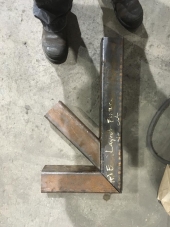I came up with an idea for making a neat heat riser from diagonally cut firebricks. Since I have learned so much from everyone I wanted to share it. It's been a year and I STILL haven't finished with my other chores so I could build the whole daned thing - hopefully I will get to that befoire the end of this month (or next month, or the one after that : - )
The trick is to get a cheap diamond blade (I got a 10" blade fro under $20 at the box store, and made a "sled" for my small table saw to be able to adjust the cut precisely so that the 45 degree angle cut goes through the exact middle of the brick. Look up on you tube how to make sleds, but design yours so that it can be adjusted ever so slightly for the correct anle and location of the cut. You should be able to take both halves from one brick and put the together flat and they should perfectly match one another. This is important so that the bricks face together perfectly. Look in the video at the star shape they form. The arms of the stars all go in one direction on the same tier of bricks and then are reversed for the next tier. I built this outside on the ground. I had a hard time getting the ground perfectly level so I used the "close enough" method by putting down a mound of sand and took a piece of OSB (flake board) and moved it arond on the sand so that it was perfectly level in all directions (very important for stability) and stacked the bricks on the board. (For a permanent build I would make a small slab by pouring a bag of DRY concrete mix and spend as much time as you need to spread it out perfectly flat. (This part is sooo important, that if it took you an hour to do just this, it would not be a lot of time.) And after you stacked up the bricks, put a could two three handful's of gravel on the burn floor, which probaly would need to be renewed from time to time. (The gravel would be to protect the dust from the dry concrete mix from getting vacuumed up during cleaning, In the video, I spent the time getting the base flat, but once I got it, I was very impatient to lay up the bricks. If you look really close you will see some very small spaces between the bricks because of my impatience, but the presence of thise spaces didn't seem to affect the burn at all.
This was the absolute first burn. You will see that during the video I put my hand over the stack to get an idea how hot the fire was. The last time I did it, wow - that was hot. I didn't get a second degree burn on my tough skin, but I could feel that thing for a week.
I didn't really have a plan for stacking the bricks for the entrance tunnel, but as I recall the tunnel entrance ended up being offset just a bit which I think began the fire spiral you can see down the heat riser when my son pointed the camera down there..
The diameter of the octagon formed by the stacking oif the bricks is just about 5.5 inches. The stack was absolutely stable, because the bases was perfectly level and the way that the bricks were stacked in the alternating tiers. I am quite soue I could have stacked it with another 4 or 5 tiers of bricks and it still wouldn't have made a difference.
One thing I would do if I was going to buld a lot of them, would be to get a table saw with an attachment on it that you could hook up a really strong shop vac to cut down on the dust, which really wasn't all that bad considering how many bricks I had to cut.
I do curse on a regular basis in the video, as I really hadn't thought that it would work so well on the first burn, or i would have moderated my language some, so you might not to have kids present when you watch it.
https://onedrive.live.com/?cid=373bc244e577ab46&id=373BC244E577AB46%21655&action=Share&v=3

 1
1













































